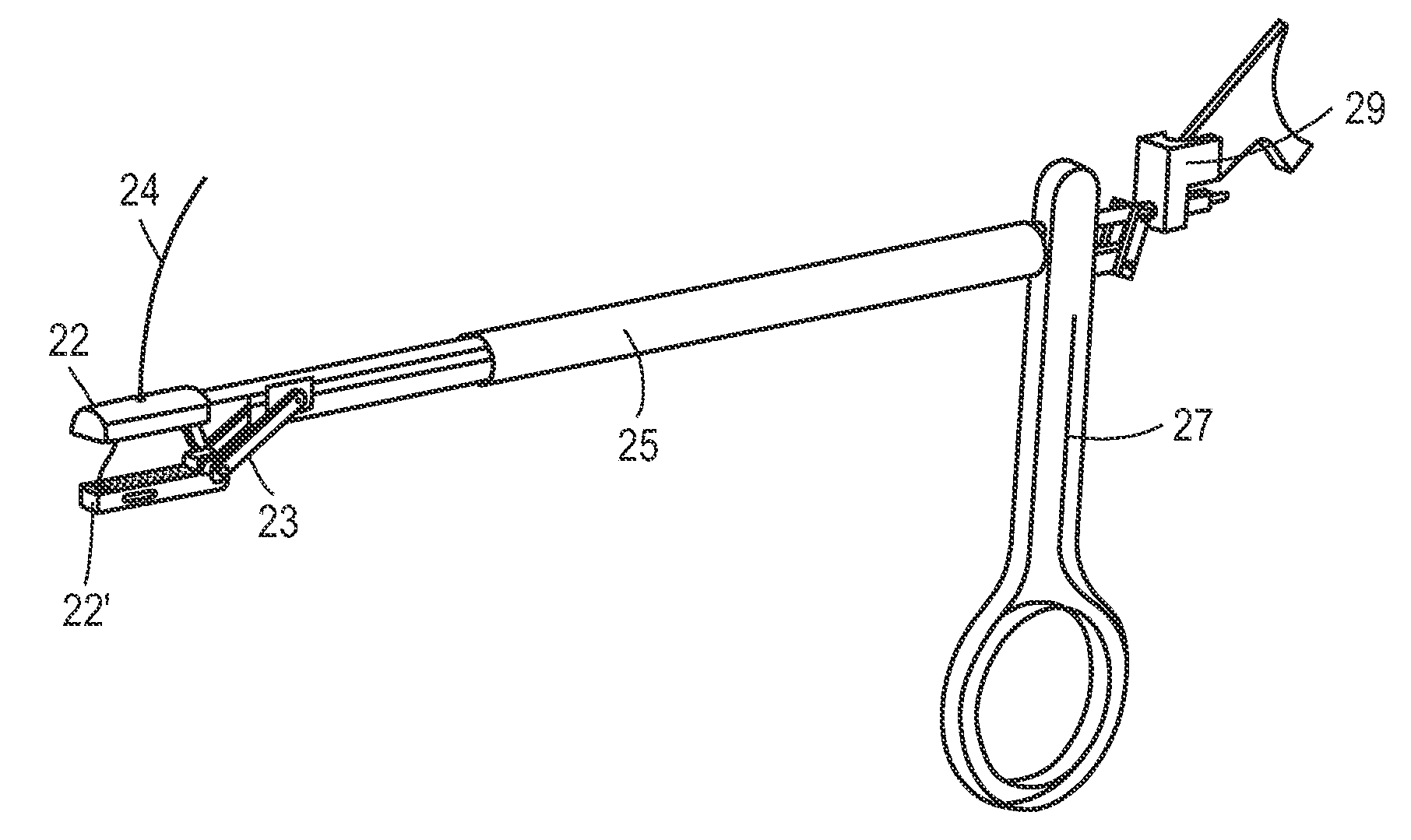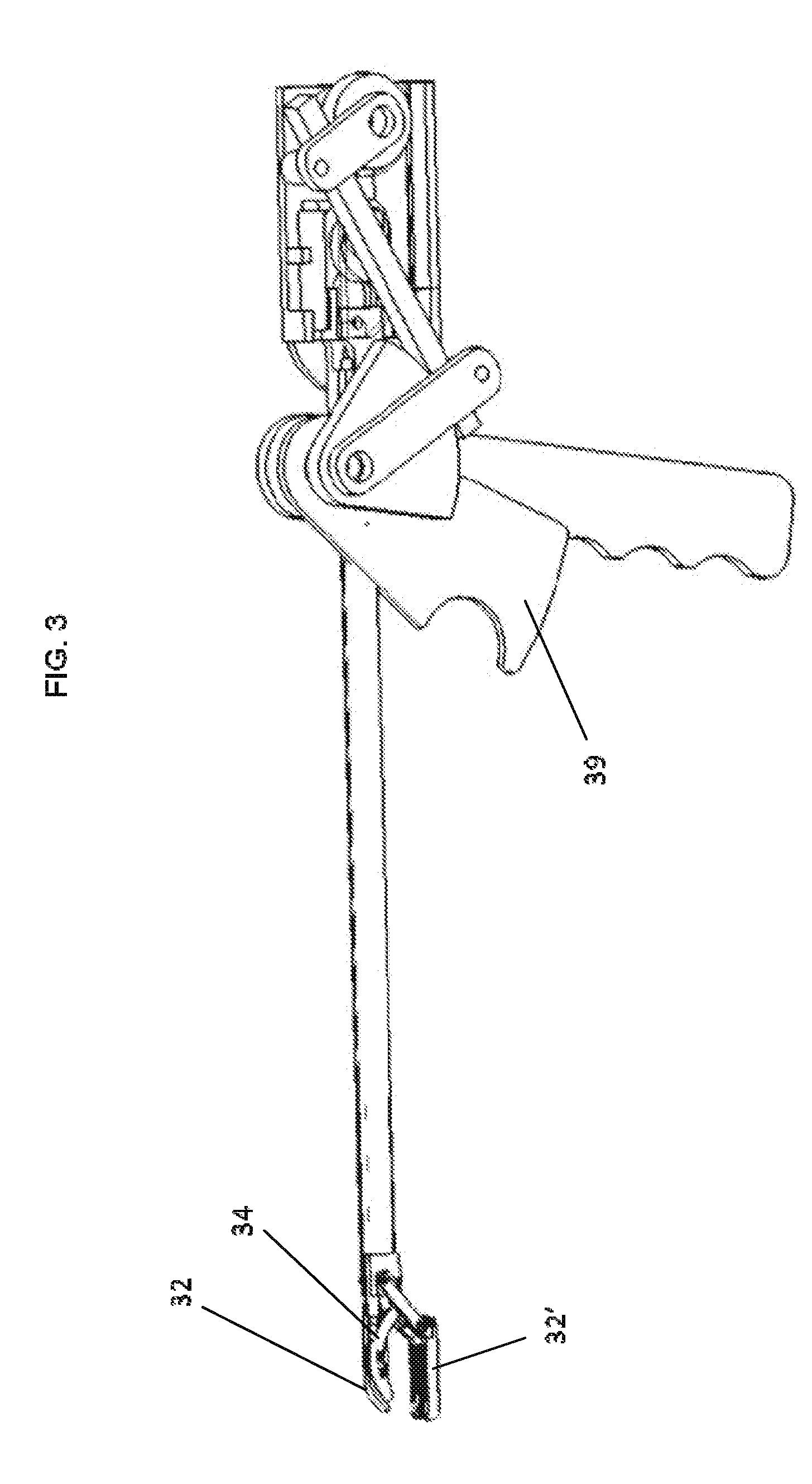The first jaw may include a first tissue contacting surface and the second jaw comprises a second tissue contacting surface, and further wherein the first tissue contacting surface and the second tissue contacting surface are substantially parallel when the jaws are open. Parallel opening of the jaws may allow larger thickness or areas of tissue to be grasped or manipulated (e.g. sutured), because as the jaws close they apply approximately the same force over a large area of the tissue, rather than over a small region. This may prevent “pinching” or damage to tissue, particularly near the region in which the jaws are hinged. Furthermore, the suture passer jaws may also act as a tissue clamp or grasper, holding the tissue securely as the suture is passed through it.
A jaw control may be a proportional control that is limited. Thus, a limiter may be included to limit the motion of the jaw(s) when the jaw control is used. A limiter may prevent the jaws from applying pressure above some threshold, preventing or limiting damage to the tissue, while still allowing it to be secured between the jaws. In some variations, this limiter is adjustable. The limiter may not completely prevent additional pressure from being applied, but it may limit it by, for example, increasing the proportionality of the proportional jaw control. Thus, as more force is applied to the control, smaller and smaller percentages of this force are translated to the tissue (either linearly or above a threshold). The force applied may be fed back to the limiter along the control mechanism. For example, the limiter may be in communication with the mechanical control mechanism (e.g., cables, pushers, etc.), pneumatic control mechanism, magnetic control mechanism, electric control mechanism, etc. In some variations, the limiter limits force applied by the jaws when the force exceeds about 20 lb (or about 5 lb, about 10 lb, about 15 lb, about 25 lbs, etc.). The linkage between the jaw movement and the jaw control may include a mechanical advantage (e.g., approximately 1.25:1). Thus, if you apply 1 pound of force to the jaw control, the jaw exerts 1.25 pounds of clamping force on the tissue over a range of pressures (particularly in variations including a limiter).
In addition to the jaw control, the handle of a suture passer may include additional controls that can control other aspects of the device, such as the angle of deflection of the distal end of the device. Thus, in some variations the distal end of the device (e.g., including the jaws or a portion of the jaws) may be bent or deflected. Deflection of the distal end may help improving steering of the device within a subject's body, as well as improving access to difficult to reach regions. In some variations, the handle includes a distal tip deflector control that is configured to control deflection of the distal end of the device.
Also described herein are continuous suture passers having suture channels, passages or guides for controlling the position of the suture with respect to the distal and / or intermediate region of the suture passer as the suture passer is operated. For example, a suture passer may include a first jaw and a second jaw, a handle including a jaw control to manipulate at least one jaw, and a first suture shuttle dock functionally connected to the first jaw, wherein the first suture shuttle dock is configured to releasably secure a suture shuttle so that the suture shuttle may be passed between the first and second jaws. The first suture shuttle dock may include a suture passage to at least partially guide a suture connected to the suture shuttle when the suture shuttle is engaged with the first suture shuttle dock. The suture passage (or guide) may allow the shuttle to reside completely within the jaws, and because it prevents the suture from interfering with the penetrator as the tissue penetrator passes through tissue or interacts with the opposite jaw (e.g., a shuttle dock region on the opposite jaw).
In some variations, the suture passer also includes an intermediate region between the first and second jaws and the handle that has a suture channel that is configured to guide the suture extending from the first or second jaws. For example, the suture channel may be an opening extending longitudinally along the intermediate region. Thus, the suture channel may prevent the suture from impinging between the shaft of the device an inner wall of a cannula which may be used to position the suture passer, particularly in endoscopic and arthroscopic applications.
Also described herein are suture shuttles. A suture shuttle may include a suture attachment region configured to secure to a surgical suture, a shuttle body having an outer surface that is substantially blunt, and a shuttle retainer region configured to engage a tissue penetrator to retain the suture shuttle in communication with the tissue penetrator. The shuttle body region may have an outer diameter that is less than 5 mm. The suture shuttles described herein may also include a shuttle alignment feature, wherein the shuttle alignment feature communicates with a region of the tissue penetrator and a region of a suture shuttle dock to orient the suture shuttle. A shuttle alignment feature may help organize and control the suture attached to the suture shuttle. For example, by helping position the suture into a suture guide or channel as the suture shuttle is passed between the jaws of a suture passer. A shuttle alignment feature may include a groove in the shuttle body.
 Login to View More
Login to View More  Login to View More
Login to View More 


